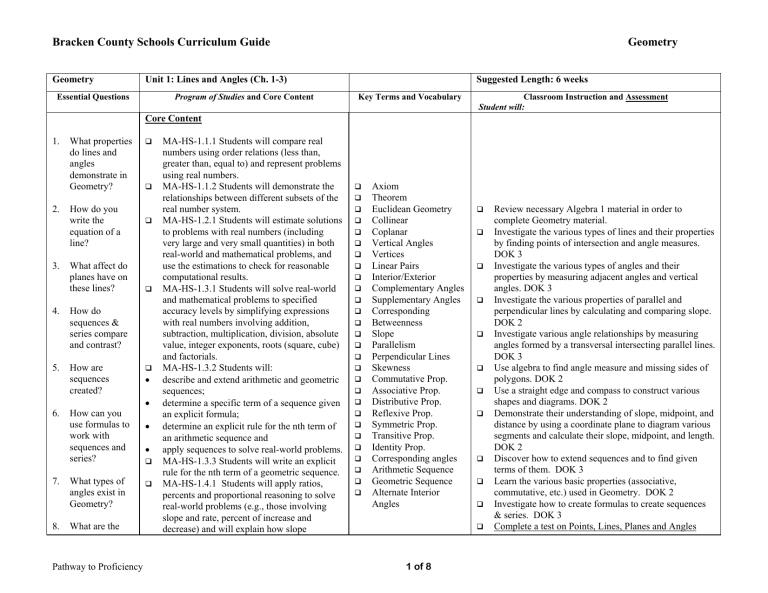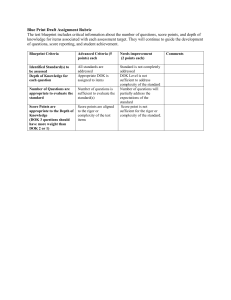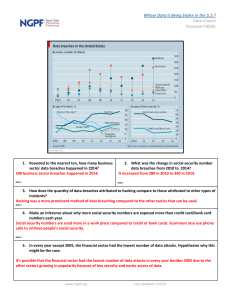
Bracken County Schools Curriculum Guide Geometry Geometry Unit 1: Lines and Angles (Ch. 1-3) Essential Questions Program of Studies and Core Content Suggested Length: 6 weeks Key Terms and Vocabulary Classroom Instruction and Assessment Student will: Core Content 1. What properties do lines and angles demonstrate in Geometry? 2. How do you write the equation of a line? 3. What affect do planes have on these lines? 4. How do sequences & series compare and contrast? 5. How are sequences created? • • 6. How can you use formulas to work with sequences and series? 7. What types of angles exist in Geometry? 8. What are the Pathway to Proficiency • • MA-HS-1.1.1 Students will compare real numbers using order relations (less than, greater than, equal to) and represent problems using real numbers. MA-HS-1.1.2 Students will demonstrate the relationships between different subsets of the real number system. MA-HS-1.2.1 Students will estimate solutions to problems with real numbers (including very large and very small quantities) in both real-world and mathematical problems, and use the estimations to check for reasonable computational results. MA-HS-1.3.1 Students will solve real-world and mathematical problems to specified accuracy levels by simplifying expressions with real numbers involving addition, subtraction, multiplication, division, absolute value, integer exponents, roots (square, cube) and factorials. MA-HS-1.3.2 Students will: describe and extend arithmetic and geometric sequences; determine a specific term of a sequence given an explicit formula; determine an explicit rule for the nth term of an arithmetic sequence and apply sequences to solve real-world problems. MA-HS-1.3.3 Students will write an explicit rule for the nth term of a geometric sequence. MA-HS-1.4.1 Students will apply ratios, percents and proportional reasoning to solve real-world problems (e.g., those involving slope and rate, percent of increase and decrease) and will explain how slope Axiom Theorem Euclidean Geometry Collinear Coplanar Vertical Angles Vertices Linear Pairs Interior/Exterior Complementary Angles Supplementary Angles Corresponding Betweenness Slope Parallelism Perpendicular Lines Skewness Commutative Prop. Associative Prop. Distributive Prop. Reflexive Prop. Symmetric Prop. Transitive Prop. Identity Prop. Corresponding angles Arithmetic Sequence Geometric Sequence Alternate Interior Angles 1 of 8 Review necessary Algebra 1 material in order to complete Geometry material. Investigate the various types of lines and their properties by finding points of intersection and angle measures. DOK 3 Investigate the various types of angles and their properties by measuring adjacent angles and vertical angles. DOK 3 Investigate the various properties of parallel and perpendicular lines by calculating and comparing slope. DOK 2 Investigate various angle relationships by measuring angles formed by a transversal intersecting parallel lines. DOK 3 Use algebra to find angle measure and missing sides of polygons. DOK 2 Use a straight edge and compass to construct various shapes and diagrams. DOK 2 Demonstrate their understanding of slope, midpoint, and distance by using a coordinate plane to diagram various segments and calculate their slope, midpoint, and length. DOK 2 Discover how to extend sequences and to find given terms of them. DOK 3 Learn the various basic properties (associative, commutative, etc.) used in Geometry. DOK 2 Investigate how to create formulas to create sequences & series. DOK 3 Complete a test on Points, Lines, Planes and Angles Bracken County Schools Curriculum Guide Geometry Essential Questions similarities and differences between polygons and circles? 9. How are polygons and circles different? 10. How do you solve systems of equations? Pathway to Proficiency Geometry Unit 1: Lines and Angles (Ch. 1-3) Program of Studies and Core Content Suggested Length: 6 weeks Key Terms and Vocabulary Classroom Instruction and Assessment Student will: (Chapter 1) CLA DOK 3 Complete a test on sequences and series CLA DOK 3 Complete a test on Parallel and Perpendicular Lines (Chapter 3) CLA DOK 3 determines a rate of change in linear functions representing real-world problems. MA-HS-1.5.1 Students will identify real number properties (commutative properties of addition and multiplication, associative properties of addition and multiplication, distributive property of multiplication over addition and subtraction, identity properties of addition and multiplication and inverse properties of addition and multiplication) when used to justify a given step in simplifying an expression or solving an equation. MA-HS-1.5.2 Students will use equivalence relations (reflexive, symmetric, transitive). MA-HS-2.2.1 Students will continue to apply to both real-world and mathematical problems U.S. customary and metric systems of measurement. MA-HS-3.1.1 Students will analyze and apply spatial relationships (not using Cartesian coordinates) among points, lines, and planes (e.g., betweenness of points, midpoint, segment length, collinear, coplanar, parallel, perpendicular, skew). DOK 2 MA-HS-3.1.2 Students will use spatial relationships to prove basic theorems. MA-HS-3.1.3 Students will analyze and apply angle relationships (e.g., linear pairs, vertical, complementary, supplementary, corresponding, and alternate interior angles) in real-world or mathematical problems. DOK 2 MA-HS-3.1.4 Students will use angle relationships to prove basic theorems. MA-HA-3.1.5 Students will classify and apply properties of two-dimensional 2 of 8 Bracken County Schools Curriculum Guide Geometry Essential Questions Geometry Unit 1: Lines and Angles (Ch. 1-3) Program of Studies and Core Content Suggested Length: 6 weeks Key Terms and Vocabulary geometric figures (e.g., number of sides, vertices, length of sides, sum of interior and exterior angle measures). DOK 2 MA-HS-3.1.6 Students will know the definitions and basic properties of a circle and will use them to prove basic theorems and solve problems. MA-HS-3.3.1 Students will apply algebraic concepts and graphing in the coordinate plane to analyze and solve problems (e.g., finding the final coordinates for a specified polygon, midpoints, betweenness of points, parallel and perpendicular lines, the distance between two points, the slope of a segment). DOK 2 MA-HS-3.4.1 Students will identify definitions, axioms, and theorems, explain the necessity of, them and give examples of definitions them. MA-HS-3.4.3 Students will be able to perform constructions such as a line parallel to a given line through a point not on the line, the perpendicular bisector of a line segment and the bisector of an angle. Pathway to Proficiency 3 of 8 Classroom Instruction and Assessment Student will: Bracken County Schools Curriculum Guide Geometry Essential Questions Geometry Unit 2: Triangles (Ch. 4-7) Program of Studies and Core Content Suggested Length: 12 weeks Key Terms and Vocabulary Classroom Instruction and Assessment Student will: Core Content 1. What are the differences between isosceles, scalene, and equilateral triangles? 2. What are the differences between acute, obtuse, right and equilateral Triangles? 3. What are angle bisectors, medians, altitudes, and perpendicular bisectors? 4. What are trigonometric ratios and how do they relate to sine, cosine, and tangent? 5. What is the difference between congruency and similarity, and Pathway to Proficiency MA-HS-1.3.1 Students will solve real-world problems and mathematical problems to specified accuracy levels by simplifying expressions with real numbers involving addition, subtraction, multiplication, division, absolute value, integer exponents, roots (square, cube), and factorials. DOK 2 MA-HS-1.4.1 Students will apply ratios, percents and proportional reasoning to solve real-world problems (e.g., those involving slope and rate, percent of increase and decrease) and will explain how slope determines a rate of change in linear functions representing real-world problems. DOK 2 MA-HS-2.1.3 Students will apply definitions and properties of right triangle relationships (right triangle trigonometry and the Pythagorean theorem) to determine length and angle measures to solve real-world and mathematical problems. DOK 2 MA-HS-2.1.4 - Students will apply special right triangles and the converse of the Pythagorean theorem to solve real-world problems. MA-HS-2.2.1 Students will continue to apply to both real world and mathematical problems U.S. customary and metric systems of measurement. MA-HS-3.1.5 Students will classify and apply properties of two-dimensional geometric figures (e.g., number of sides, Pythagorean theorem Trigonometric ratios Relationships Ratio Proportion Sine Cosine Tangent Rotation Transitive Congruence 4 of 8 Demonstrate understanding of the various types of triangles, and the various properties they exhibit. DOK 2. Investigate the various types of triangle congruencies by comparing measures of angles and sides. DOK 2 Investigate the various types of special segments in triangles by constructing each. DOK 2 Demonstrate their understanding of ratios and proportions by calculating the amount of fertilizer needed for a field or the run of a wheelchair ramp given the slope and the rise, and to otherwise solve triangles. DOK 3 Investigate similarity by using the mirror method or shadow method of indirect measurement to find the height of the flagpole, school building and etc. DOK 3 Complete a test on Congruent Triangles (Chapter 4) DOK 3 Complete a test on Relationships in Triangles (Chapter 5) CLA DOK 3 Complete a test on Proportions and Similarity (Chapter 6) CLA DOK 3 Complete a test on Right Triangles and Trigonometry (Chapter 7) CLA DOK 3 Bracken County Schools Curriculum Guide Geometry Essential Questions how do they relate to triangles? 6. How can triangles be used to find indirect measurements? Pathway to Proficiency Geometry Unit 2: Triangles (Ch. 4-7) Program of Studies and Core Content Suggested Length: 12 weeks Key Terms and Vocabulary vertices, length of sides, sum of interior and exterior angle measures). DOK 2 MA-HS-3.1.12 Students will apply the concepts of congruence and similarity to solve real-world and mathematical problems. DOK 3 MA-HS-3.1.13 Students will prove triangles congruent and similar. MA-HS-3.3.1 Students will apply algebraic concepts and graphing in the coordinate plane to analyze and solve problems (e.g., finding the final coordinates for a specified polygon, midpoints, betweenness of points, parallel and perpendicular lines, the distance between two points, the slope of a segment). DOK 2 MA-HS-5.1.7 Students will apply and use direct and inverse variation to solve realworld and mathematical problems. MA-HS-5.2.1 Students will apply order of operations, real number properties (identity, inverse, commutative, associative, distributive, closure) and rules of exponents (integer) to simplify algebraic expressions.. 5 of 8 Classroom Instruction and Assessment Student will: Bracken County Schools Curriculum Guide Geometry Essential Questions Unit 3: Quadrilaterals and Circles 10) Geometry (Ch. 8- Program of Studies and Core Content Suggested Length: 9 weeks Key Terms and Vocabulary Classroom Instruction and Assessment Student will: Core Content 1. 2. What properties make a quadrilateral different from other geometric figures? What are the properties of quadrilaterals? 3. How do the various transformations affect the properties of quadrilaterals? 4. What is a vector? 5. How does it affect the properties of a quadrilateral? 6. What are the properties of circles? 7. How do transformations on circles differ from Pathway to Proficiency MA-HS-3.2.1Students will identify and describe properties of and apply geometric transformations within a plane to solve real-world and mathematical problems. DOK 3 MA-HS-2.1.3 Students will apply definitions and properties of right triangle relationships (right triangle trigonometry and the Pythagorean theorem) to determine length and angle measures to solve real-world and mathematical problems. MA-HS-2.1.4 Students will apply special right triangles and the converse of the Pythagorean theorem to solve real-world problems MA-HS-3.1.5 Students will classify and apply properties of two-dimensional geometric figures (e.g., number of sides, vertices, length of sides, sum of interior and exterior angle measures). MA-HS-3.1.12 Students will apply the concepts of congruence and similarity to solve real-world and mathematical problems. MA-HS-5.1.1 Students will identify multiple representations (tables, graphs, equations) of functions (linear, quadratic, absolute value, exponential) in real-world or mathematical problems. Transformation Quadrilateral Kite Trapezoid Parallelogram Rhombus Rectangle Square N-gon Diagonals Rotation Translation Congruence Dilation Reflection 6 of 8 Ιnvestigate the various properties of quadrilaterals by comparing angle, side and diagonal measure. DOK 2 Classify various types of quadrilaterals and polygons based on various properties they exhibit. DOK 2 Ιnvestigate the various properties of transformations by using vectors. Examine how different transformations are used to create patterns and problems with similar figures. DOK 2 Ιnvestigate the various properties of circles by measuring angles formed by chords, secants, and tangents. DOK 3 Investigate and classify polygons by creating mobiles or other representations that compare/contrast those polygons. DOK 3 Demonstrate their understanding of quadrilaterals and other polygons by finding angle and side measures. DOK 2 Complete a test on Chapter 8 (Quadrilaterals). DOK 3 Complete a test on Chapter 9 (Transformations). DOK 3 Complete a test on Chapter 10 (Circles). DOK 3 Bracken County Schools Curriculum Guide Geometry Essential Questions Unit 3: Quadrilaterals and Circles 10) Geometry (Ch. 8- Program of Studies and Core Content Suggested Length: 9 weeks Key Terms and Vocabulary Classroom Instruction and Assessment Student will: transformations on polygons? 8. How do arcs, chords, central angles, and inscribed angles behave in circles? 9. What effect do reflections, rotations, translations, and dilations have on two and threedimensional objects? Geometry Essential Questions Unit 4: Area and Volume (Ch. 11-12) Program of Studies and Core Content Suggested Length: 9 weeks Key Terms and Vocabulary Classroom Instruction and Assessment Student will: Core Content 1. How does one find the area of a figure? 2. How does one find the volume of a shape? 3. How does manipulation of a Pathway to Proficiency MA-HS-2.1.1Students will determine the surface area and volume of right rectangular prisms, pyramids, cylinders, cones, and spheres in real-world and mathematical problems. DOK 2 MA-HS-2.1.2 Students will describe how a change in one or more dimensions of a geometric figure affects the perimeter, area and volume of the figure. DOK 3 Demonstrate their understanding of formulas by finding area, surface area, and volume of prisms, cylinders, cones, and pyramids. DOK 3 Investigate the effect on surface area and volume if one of the parameters is changed (length, width, or height). DOK 3 2–D 3–D 7 of 8 Bracken County Schools Curriculum Guide Geometry Essential Questions particular part of a figure effect the area & volume? 4. In what way are the number of faces/sides/vertices of a figure related? Pathway to Proficiency Geometry Unit 4: Area and Volume (Ch. 11-12) Program of Studies and Core Content MA-HS-2.2.1 Students will continue to apply to both real-world and mathematical problems U.S. customary and metric systems of measurement. MA-HS-3.1.5 Students will classify and apply properties of two-dimensional geometric figures (e.g., number of sides, vertices, length of sides, sum of interior and exterior angle measures). MA-HS-3.1.6 Students will know the definitions and basic properties of a circle and will use them to prove basic theorems and solve problems. MA-HS-3.1.9 Students will classify and apply properties of three-dimensional geometric figures (e.g., number of edges, faces, vertices). DOK 2 MA-HS-3.1.10 Students will describe the intersection of a plane with a threedimensional figure. MA-HS-3.1.11 Students will visualize solids and surfaces in three-dimensional space when given two-dimensional representations (e.g., nets multiple views) and create twodimensional representations for the surfaces of three-dimensional objects. MA-HS-3.1.12 Students will apply the concepts of congruence and similarity to solve real-world and mathematical problems. Suggested Length: 9 weeks Key Terms and Vocabulary Faces Bases Polyhedrons Prisms Pyramids Cylinder Cone Sphere 8 of 8 Classroom Instruction and Assessment Student will: Investigate the various forms of polyhedrons and examine how they relate to various items in the realworld. (dice, for example) DOK 2 Classify polyhedrons based on attributes such as numbers of vertices, sides, and faces, and compare and contrast these 3-D objects. DOK 3 Create a polyhedron of given properties, and be able to tell properties of it. DOK 3 Complete a test on Chapter 11 (Area). CLA DOK 3 Complete a test on Chapter 12 (Surface Area). CLA DOK 3 Complete a test on Chapter 13 (Volume). CLA DOK 3






